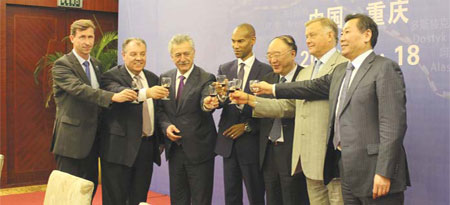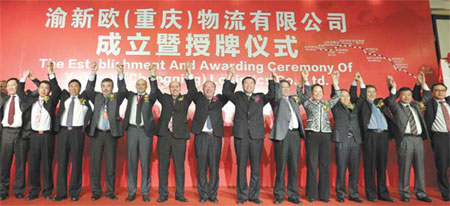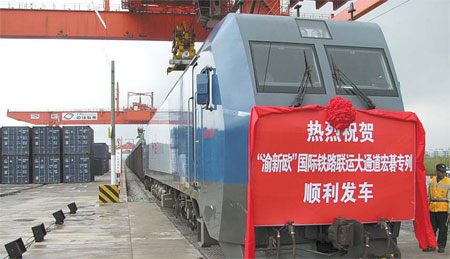Intl railway promises to revive Silk Road
Tan Yingzi
Updated:2014-03-29
China Daily
New town and launch of regular trains to boost modernized trading routes between East and West, Tan Yingzi reports from Chongqing
Legend has it that Chinese emperor Han Wu Di (156-87 BC) once looked to the lands west of his vast empire and proclaimed them full of people who placed "great value on the rich produce of China".
That regal observation spurred exploration of those foreign lands, leading to a network of trading routes between the East and West that came to be known as the Silk Road.
But the historic route declined in the centuries that followed as maritime trade increased.
Now China is building a modern version of the ancient world's renowned trade routes to bring back the glory days - instead of camels, modern travelers will use cars, trains and planes.
The latest addition to this effort is the Chongqing-Xinjiang-Europe international railway, which started operating in 2011.
Starting in Chongqing, the only municipality in inland China, the Asia-Europe rail link project bridges East and West and connects North and South.
The megacity boasts a population of 32 million and is one of the largest and fastest growing cities in the world.
Chongqing opened a line to form part of the new route in the north at Shaanxi's provincial capital Xi'an - the historical city that flourished as the Chinese terminus of the Silk Road centuries ago.
The new link offers an attractive alternative for trading companies in Chongqing that otherwise use the more time consuming and costly maritime route via southern Chinese coastal ports, including Shanghai or Guangzhou, before shipping goods through the Strait of Malacca.
The 11,000 km route passes through Xi'an, Lanzhou, Urumqi and the Alataw Pass, where it crosses the border into Kazakhstan. It then continues through Russia, Belarus and Poland before ending in Duisburg, Germany.
Chongqing authorities say the railway puts the city on the map as an international logistics hub by connecting the Yangtze River Delta economic belt to Europe.
The journey takes an average of 16 days, less than half the time of the maritime route, and is changing Chongqing's role from an inland city to a bridgehead for China's gateway to the West.
In addition, customs and tariff procedures have been simplified to make international trade more convenient.
Thanks to the railway, PC products manufacturer Hewlett Packard, which has laptop factories in Chongqing, saved significant transport costs and time, benefiting its consumers worldwide, said Tony Prophet, HP's senior vice-president.
In 2011, trains ran just once a month. Now they run every day and the number of departures is expected to rise to three per day by 2015.
While shipping laptops, mechanical and electrical products and car parts made in Chongqing to Europe, the railway still has to deal with relatively high freight costs, as there are few China-bound goods.
According to YuXinOu (Chongqing) Logistics, since 2011, 95 train services carried cargo worth more than $2 billion from Chongqing but only one cargo train ran from Europe. The first return cargo train carried Ford car parts from Duisburg, Germany, at the end of February 2013, and arrived in Chongqing 17 days later on March 18.
The rail link is now the busiest cargo freight route between China and Europe, according to the logistics company.
To meet the increasing demand of the Sino-Euro trade, the company recently announced that the first train with a regular weekly schedule between Chongqing and Europe will leave on April 8.
Self-developed insulated containers mean YuXinOu Logistics can now also transport the products during winter.
The cost of each wagon to Europe is $8,000, but the figure is expected to fall to about $5,000 to $6,000 as more European goods are carried back to China via the link.
To benefit from the increase in trains and encourage more trade a new free trade port town will be built in the Chongqing Liangjiang New Area. Work was due to start on March 29, and the town is expected to be up and running by November 2015.
The national development area is the third to be approved directly by the State Council, following Shanghai's Pudong New Area and the Binhai New Area in Tianjin.
The Chongqing Free Trade Port Town received 10 billion yuan ($1.6 billion) for investment projects including new hotels, shopping malls and office buildings.
The town will be built around a trade center, which was established in 2011. The center is a commercial platform for business people in China and abroad to exchange information and products.
To date 400 companies have moved into the center, including 13 Fortune 500 companies.
To help facilitate trade with Europe a logistics center and an e-commerce center will also be built.
In early May, three logistics companies from the United States, Italy and Australia invested 5.4 billion yuan in the region to tap the potential opportunities.
Spearheading the New Silk Road
In a speech in Kazakhstan last year, President Xi Jinping proposed that China and the Central Asian countries build an "economic belt along the Silk Road".
The trans-Eurasian project would target more than 3 billion people and represent the single biggest market in the world, one with unparalleled potential.
In his work report at the start of the second session of the 12th National People's Congress in March, Premier Li Keqiang said that the government will push forward the establishment of the Silk Road economic belt, which may eventually encompass more than 40 countries.
Chongqing is applying to be the start of the Silk Road economic belt and the hub of a 21st century maritime Silk Road, connecting the Chinese interior to the world.
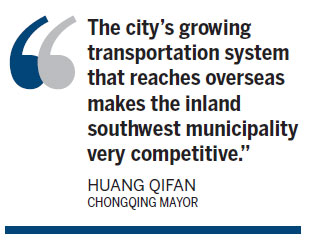
Chongqing Mayor Huang Qifan said the city's growing transportation system that reaches overseas makes the inland southwest municipality very competitive.
This year, many provinces applied to become part of the Silk Road economic belt to increase their overseas connections.
Huang said Chongqing's advantage is that it connects with other cities by air, rail and water. "The Yangtze River gateway has great potential," he said, adding that the cargo volume could double or even triple.
Inland provinces, such as Sichuan and Shaanxi, are also applying to be the start of the belt.
"Chongqing's electronic industries are needed in European countries," Huang said, adding that a cluster of industries in the city make products that are needed by the world and would also be important to open up.
The mayor said, "Chongqing is one step ahead in taking the initiative in the economic belt." He pointed out that the municipality has been shipping goods to Europe via the trans-Eurasian railway network since 2011.
Chongqing has already started to seek cooperation with Russia, which is about to establish a consulate in the municipality. Direct flights to several Russian cities will begin this year and a Sino-Russian industrial park will be built in Liangjiang New Area that will focus on aviation-related manufacturing, including helicopter parts and engines.
Contact the writer at tanyingzi@chinadaily
For further information, please contact
Yuxinou (Chongqing) Logistics Ltd Co
Sales Department: +86 023-67623895
Cargo service registration: 400-630-0002
Website: www.yuxinoulogistics.com
|
Russian and Chinese representatives, including Chongqing Mayor Huang Qifan (third from right), toast the success of the cooperation on the Chongqing-Xinjiang-Europe railway in 2013. |
|
Chinese and foreign delegates celebrate the establishment of a logistics company in Chongqing, which has capitalized on the international railway to provide its clients with freight services. |
|
A train shipping IT products first sets off for Europe from the Chongqing railway station via the inter-continental railway in 2011. Photos Provided to China Daily |
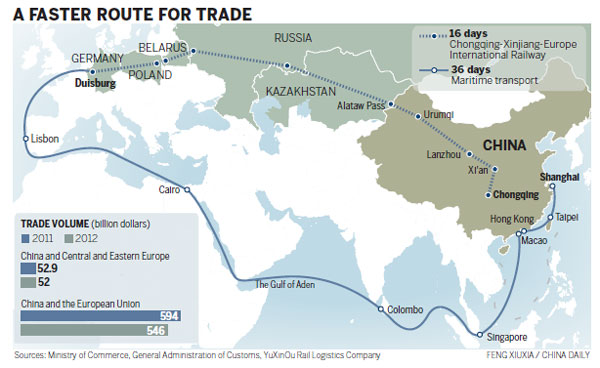
(China Daily 03/29/2014 page6)
Video
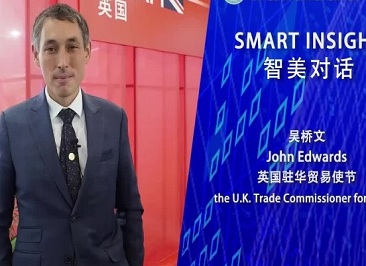
John Edwards, the UK trade commissioner for China, praised Chongqing over its rise as a burgeoning center in intelligent manufacturing.



